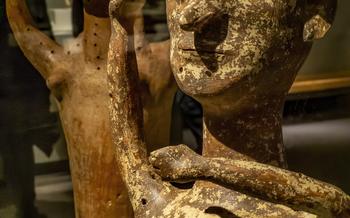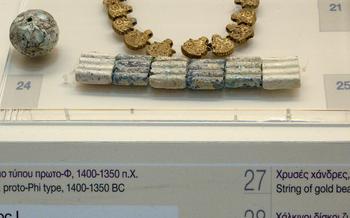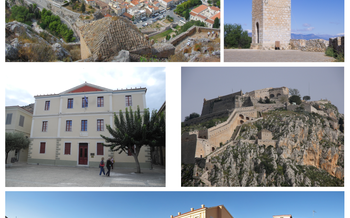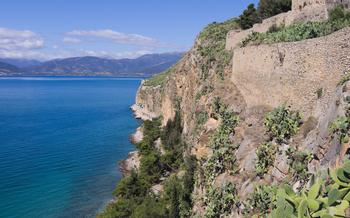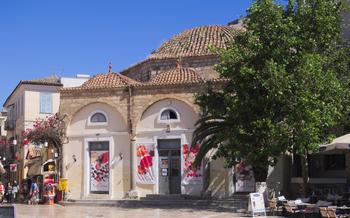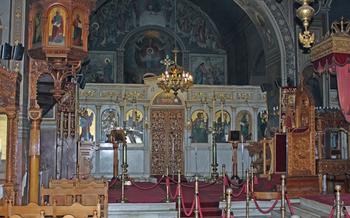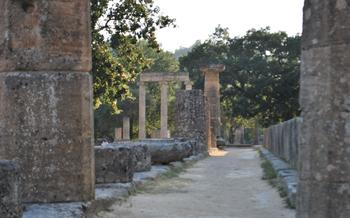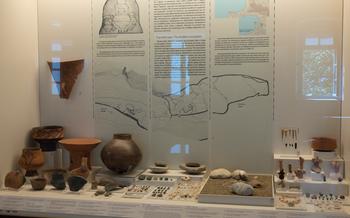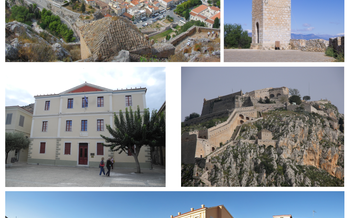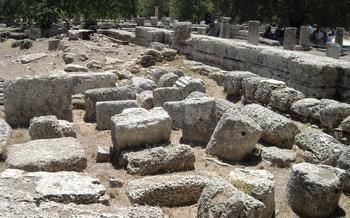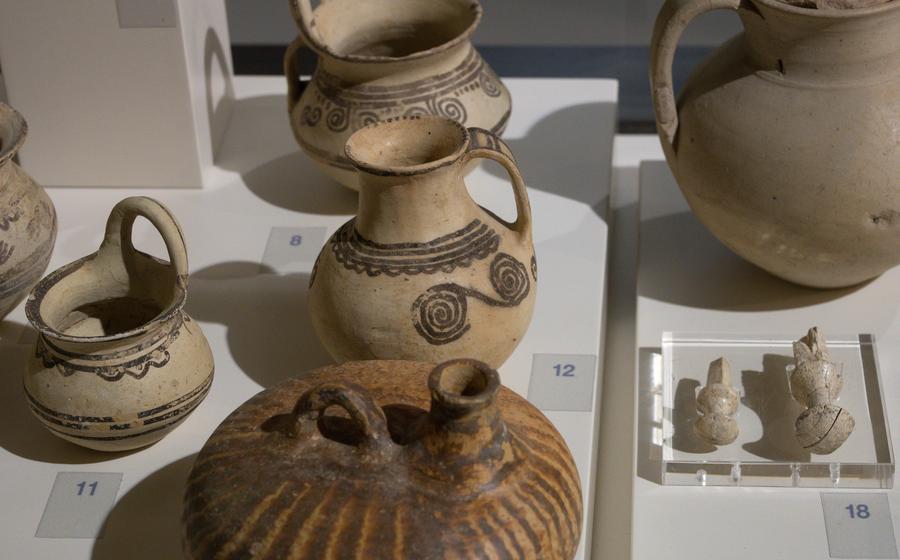
The Treasury of Atreus (Tholos Tomb)
- A Journey to the Past: Exploring the Treasury of Atreus
- The History and Significance of the Treasury of Atreus
- The Treasury of Atreus: An Architectural Masterpiece
- Unraveling the Legends and Myths Surrounding the Treasury of Atreus
- A Step-by-Step Guide to Visiting the Treasury of Atreus
- The Treasury of Atreus: An Immersive Experience
- Tips for Making the Most of Your Visit to the Treasury of Atreus
- Nearby Attractions to Complement Your Visit
- The Treasury of Atreus: Beyond the Mycenaean Era
- The Archaeological Significance of the Treasury of Atreus
- The Treasury of Atreus as a Symbol of Power and Prestige
- Controversies and Debates Surrounding the Treasury of Atreus
- The Treasury of Atreus in Modern Times
- Insider Tip: Enhancing Your Experience
A Journey to the Past: Exploring the Treasury of Atreus
In the heart of the Peloponnese, Greece, lies a captivating journey to the past, leading you to the awe-inspiring Treasury of Atreus. This ancient Mycenaean tomb, also known as the Tholos Tomb, stands as a testament to the ingenuity and grandeur of a civilization that flourished over three millennia ago.
As you approach the Treasury of Atreus, its imposing beehive-shaped dome, crafted from massive stone blocks, commands attention. Intriguing legends surround this remarkable structure, associating it with King Agamemnon, the legendary leader of the Greek forces in the Trojan War.
Practical information for your visit: The Treasury of Atreus is conveniently located in Mycenae, within easy reach of Athens. Public transportation options are available, making it accessible to visitors from various regions. Visiting hours vary depending on the season, so planning in advance is recommended. Admission fees are applicable, but discounts are offered to students and seniors.
The History and Significance of the Treasury of Atreus
The Treasury of Atreus, also known as the Tomb of Agamemnon, stands as a testament to the remarkable achievements of the Mycenaean civilization that flourished in Greece during the Bronze Age (1600-1100 BC). This impressive tholos tomb, constructed around 1350 BC, served as a royal burial chamber, likely for King Atreus or one of his successors. Its grand scale and intricate architecture reflect the power and prestige of the Mycenaean rulers and offer valuable insights into their funerary practices and beliefs.
The Mycenaeans, known for their advanced culture and sophisticated craftsmanship, built the Treasury of Atreus using a corbelled vault technique, a remarkable feat of engineering for its time. The tomb's impressive dimensions, with a height of 5 meters and a diameter of 5 meters, demonstrate the Mycenaeans' mastery of construction and their ability to create monumental structures. The massive stone blocks, some weighing several tons, were carefully fitted together without the use of mortar, showcasing the exceptional engineering skills of the Mycenaean builders.
The Treasury of Atreus's historical significance extends beyond its architectural prowess. Its status as a UNESCO World Heritage Site recognizes its outstanding universal value and its contribution to our understanding of ancient civilizations. The tomb's remarkable preservation, despite its age, provides a unique glimpse into the Mycenaean culture and their burial customs, offering a tangible connection to a distant past.
The Treasury of Atreus: An Architectural Masterpiece
The Treasury of Atreus stands as a testament to the ingenuity and architectural prowess of the Mycenaean civilization. Its unique construction technique, known as the corbelled vault, sets it apart from other ancient structures. This method involves stacking large stone blocks in a gradually converging manner, creating a self-supporting domed roof without the use of mortar or cement.
The dimensions of the Treasury of Atreus are truly awe-inspiring. With a height of 5 meters, a diameter of 5 meters, and an estimated weight of over 300 tons, it is the largest and most well-preserved tholos tomb in Greece. The sheer size of the structure is a testament to the engineering capabilities of the Mycenaean civilization.
The sophisticated engineering behind the Treasury of Atreus ensured its stability and durability throughout the centuries. The corbelled vault distributes the weight of the structure evenly, creating a strong and resilient dome. The thick walls, measuring up to 5 meters in thickness, further contribute to the tomb's structural integrity.
In comparison to other Mycenaean tombs, the Treasury of Atreus stands out as an architectural masterpiece. While other tombs feature smaller dimensions and simpler construction techniques, the Treasury of Atreus represents the pinnacle of Mycenaean architectural achievement. Its grandeur, size, and sophisticated engineering make it a unique and remarkable example of ancient architecture.
Unraveling the Legends and Myths Surrounding the Treasury of Atreus
The Treasury of Atreus is intertwined with a web of captivating legends and myths, adding an air of mystery and intrigue to its already remarkable existence. Popular belief holds that the tomb belonged to King Agamemnon, the legendary leader of the Mycenaean army during the Trojan War. This association is largely influenced by Homer's epic poem, the Iliad, which immortalizes Agamemnon as a powerful and respected ruler.
Archaeological evidence, however, presents a more complex picture. While some artifacts discovered within the tomb suggest a connection to the royal family, there is no definitive proof to confirm that it was specifically Agamemnon's resting place. Other legends associate the tomb with other mythological figures, such as Clytemnestra, Agamemnon's wife, or even the hero Hercules.
The lack of conclusive evidence has fueled ongoing debates and research among historians and archaeologists. Nonetheless, the Treasury of Atreus remains a potent symbol of the rich mythology and folklore that permeate Greek history, inviting visitors to delve into a realm where myth and reality intertwine.
A Step-by-Step Guide to Visiting the Treasury of Atreus
The Treasury of Atreus is nestled in the archaeological site of Mycenae, in the Peloponnese region of Greece. Its proximity to Athens, approximately 90 kilometers away, makes it a convenient day trip from the capital. To reach the site, visitors can opt for public transportation, with buses departing from Athens and Nafplio, or drive along the scenic coastal route.
Before embarking on your visit, it is advisable to check the visiting hours, which vary depending on the season. During the summer months, the site is typically open from 8:00 AM to 8:00 PM, while in the winter, it closes earlier, around 3:00 PM. Advance planning is recommended to ensure that you have ample time to explore the tomb and the surrounding archaeological site.
Admission fees are applicable, with discounted rates for students, seniors, and groups. It is worth noting that the Treasury of Atreus is part of the Mycenae Archaeological Site, and a combined ticket grants access to other attractions within the site, including the Lion Gate and the Cyclopean walls.
The Treasury of Atreus: An Immersive Experience
Stepping into the Treasury of Atreus is like stepping back in time. The sheer size of the chamber, the massive stone blocks, and the eerie silence create an atmosphere that is both awe-inspiring and humbling. It's easy to imagine the ancient Mycenaean kings and queens being laid to rest here, surrounded by their precious treasures.
The acoustics of the chamber are also remarkable. Every sound, from a whispered word to a footfall, reverberates through the space, creating a strange and otherworldly effect. It's as if the tomb itself is trying to tell its story.
The Treasury of Atreus is a place where history, architecture, and mythology converge. It's a place where you can feel the weight of the past and connect with the ancient world in a very real way. It's an experience that will stay with you long after you've left.
Tips for an Immersive Experience:
- Turn off your phone and take a few moments to simply sit in the chamber and absorb the atmosphere.
- Close your eyes and imagine what it would have been like to be a Mycenaean king or queen, being buried in this magnificent tomb.
- Listen to the sounds of the chamber and let your imagination run wild.
- If you're feeling brave, you can even try singing or chanting in the chamber. The acoustics are amazing!
Tips for Making the Most of Your Visit to the Treasury of Atreus
To fully appreciate the grandeur and significance of the Treasury of Atreus, consider enriching your visit with the following tips:
-
Guided tours: Enhance your experience by joining a guided tour led by knowledgeable experts. These tours provide insights into the history, architecture, and mythology surrounding the tomb, bringing the ancient world to life.
-
Photography: Capture the awe-inspiring dimensions and atmospheric ambiance of the Treasury of Atreus through photography. Remember to use a wide-angle lens to encompass the vastness of the interior and experiment with different lighting conditions for dramatic effects.
-
Comfortable shoes: The path leading to the tomb involves uneven terrain, so comfortable walking shoes are essential for a safe and enjoyable visit.
-
Sun protection: As the tomb is located in an exposed area, remember to bring sunscreen, sunglasses, and a hat to protect yourself from the sun's rays.
Nearby Attractions to Complement Your Visit
Apart from the captivating allure of the Treasury of Atreus, the surrounding region boasts a treasure trove of historical and cultural gems waiting to be explored. Just a short distance away lies the ancient city of Epidaurus, renowned for its remarkably preserved theater, a testament to the architectural prowess of the ancient Greeks. This magnificent structure, nestled amidst picturesque surroundings, once hosted renowned theatrical performances and healing rituals, offering a glimpse into the vibrant cultural and spiritual life of the past.
Moreover, the picturesque seaside town of Nafplio, with its charming Venetian architecture and vibrant atmosphere, beckons visitors to delve into its rich history. Explore the narrow cobbled streets, uncover hidden gems like the imposing Palamidi Fortress, and soak in the breathtaking views of the Argolic Gulf.
Venturing further afield, the ruins of Ancient Corinth, once a prosperous city-state, await exploration. Discover the remnants of its grand temples, the bustling marketplace, and the impressive fortifications that once protected this powerful city. As you wander through these ancient sites, imagine the bustling streets filled with traders, philosophers, and ordinary people going about their daily lives.
Enrich your Peloponnese adventure by immersing yourself in these nearby attractions, each offering a unique perspective on the region's rich cultural heritage. From ancient theaters to medieval fortresses and thriving city-states, the Peloponnese unveils a captivating tapestry of history, culture, and natural beauty.
The Treasury of Atreus: Beyond the Mycenaean Era
The Treasury of Atreus has transcended its original purpose as a Mycenaean tomb, evolving into a site of diverse historical and cultural significance. During the Byzantine era, the tomb underwent a transformation, becoming a Christian place of worship. A small chapel was built within the tomb, adding a layer of religious devotion to the site.
Over the centuries, the Treasury of Atreus has become deeply entwined with local folklore and traditions. Stories and beliefs have sprung up around the tomb, weaving a tapestry of myth and legend. Locals whisper tales of hidden treasures and ancient spirits that guard the site.
In modern times, the Treasury of Atreus has found its way into popular culture and artistic representations. It has been featured in films, literature, and other creative works, capturing the imagination of people worldwide. The tomb's unique architecture and historical significance have made it an enduring symbol of the Mycenaean civilization.
The Archaeological Significance of the Treasury of Atreus
The Treasury of Atreus holds immense archaeological significance, providing valuable insights into the burial practices, technological advancements, and cultural exchange of the Mycenaean civilization.
Mycenaean Burial Practices: The tomb offers a glimpse into the funerary customs of the Mycenaeans. The elaborate construction and impressive dimensions suggest that it was reserved for royalty or high-ranking individuals. The presence of grave goods, such as jewelry, weapons, and pottery, sheds light on the beliefs and rituals associated with death and the afterlife.
Technological Advancements: The Treasury of Atreus showcases the remarkable engineering skills of the Mycenaeans. The corbelled vault technique, involving the stacking of stone blocks without mortar, demonstrates their architectural prowess. The tomb's stability and durability, despite its massive weight, are testaments to their engineering ingenuity.
Cultural Exchange: The Treasury of Atreus reveals the Mycenaeans' connections with other ancient civilizations. Similarities in architectural styles and construction techniques suggest cultural exchange and influences from regions such as Egypt and the Near East. The presence of imported goods, such as amber and ostrich eggs, further supports the notion of trade and interaction with distant lands.
The Treasury of Atreus as a Symbol of Power and Prestige
The Treasury of Atreus stands as a testament to the power and prestige of the Mycenaean civilization. Its impressive dimensions, intricate construction, and strategic location within the Mycenaean citadel speak volumes about the wealth, status, and authority of the rulers who commissioned its construction. The sheer size of the tomb, with its towering height and massive weight, conveys a sense of grandeur and invincibility. The use of corbelled vaulting, a sophisticated architectural technique, further demonstrates the engineering prowess and technological advancements of the Mycenaeans. The choice of location, overlooking the city and the surrounding countryside, underscores the symbolic importance of the tomb as a symbol of power and control. The Treasury of Atreus served as a powerful statement, proclaiming the might and majesty of the Mycenaean rulers and leaving a lasting legacy that continues to captivate and inspire visitors to this day.
Controversies and Debates Surrounding the Treasury of Atreus
The Treasury of Atreus, shrouded in mystery and intrigue, has sparked numerous controversies and debates among scholars and historians. One of the most prominent disputes centers on the tomb's intended purpose. While it is widely believed to have served as a royal burial chamber, some scholars have proposed alternative theories, suggesting it may have been a treasury, a religious sanctuary, or even an astronomical observatory.
Furthermore, the exact date of the tomb's construction remains a subject of debate. Traditional estimates place its construction in the 13th century BC, during the Mycenaean period. However, recent archaeological findings and re-evaluations of existing evidence have led some experts to suggest an earlier date, possibly in the 16th century BC.
Another ongoing debate revolves around the historical accuracy of the legends and myths associated with the tomb. While popular tradition strongly links the tomb to King Agamemnon, the legendary leader of the Greeks in the Trojan War, archaeological evidence does not provide conclusive proof of this connection. Some scholars argue that the association with Agamemnon may have arisen from later literary traditions and folklore rather than historical fact.
These controversies and debates underscore the enduring fascination and complexity of the Treasury of Atreus. They invite further research and exploration, encouraging scholars and historians to delve deeper into the mysteries surrounding this ancient monument and its place in the broader narrative of Mycenaean history and culture.
The Treasury of Atreus in Modern Times
In modern times, the Treasury of Atreus has become a significant cultural and historical landmark, attracting visitors from around the world. Its architectural grandeur, historical significance, and association with ancient Greek mythology have made it a popular tourist destination.
To preserve this remarkable monument for future generations, extensive conservation efforts have been undertaken. Archaeological research and restoration work have been carried out to maintain the structural integrity of the tomb and protect its unique features. These efforts ensure that visitors can continue to marvel at the architectural prowess and artistry of the ancient Mycenaeans.
Beyond its historical significance, the Treasury of Atreus has also become an important educational resource. It provides a tangible connection to ancient Greek history and architecture, allowing visitors to gain insights into the cultural and technological achievements of the Mycenaean civilization. Through guided tours, educational programs, and exhibits, the tomb serves as a valuable tool for promoting cultural heritage and fostering a deeper understanding of the past.
The Treasury of Atreus has also captured the imagination of modern artists and cultural figures. It has been featured in literature, film, and television, inspiring creative works that draw upon the tomb's mystique and historical significance. These artistic representations have further contributed to the enduring legacy of the Treasury of Atreus, ensuring that its story continues to resonate in contemporary culture.
Insider Tip: Enhancing Your Experience
To fully immerse yourself in the magic of the Treasury of Atreus, consider visiting during the off-season, typically from November to March. The crowds are significantly smaller, allowing you to explore the tomb at your own pace and soak in its awe-inspiring atmosphere without distractions. The reduced number of visitors also means you'll have more opportunities to engage with knowledgeable guides and ask questions, ensuring a deeper understanding of the site's history and significance. Additionally, the cooler temperatures and softer lighting during this time create a unique and serene ambiance, allowing you to connect with the ancient energy of the place on a more profound level.
